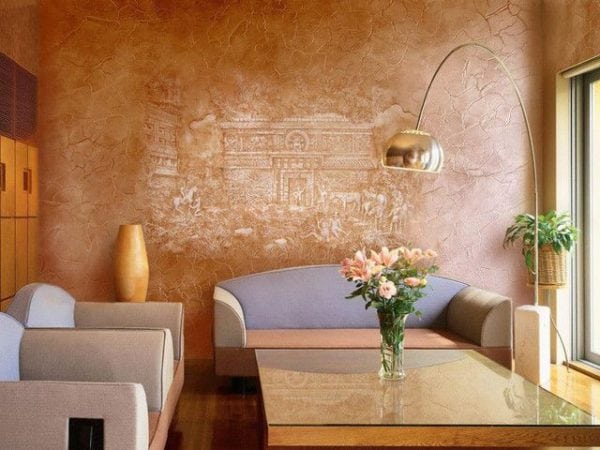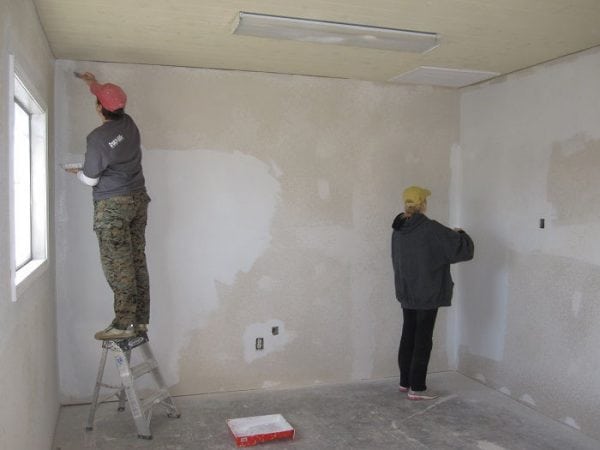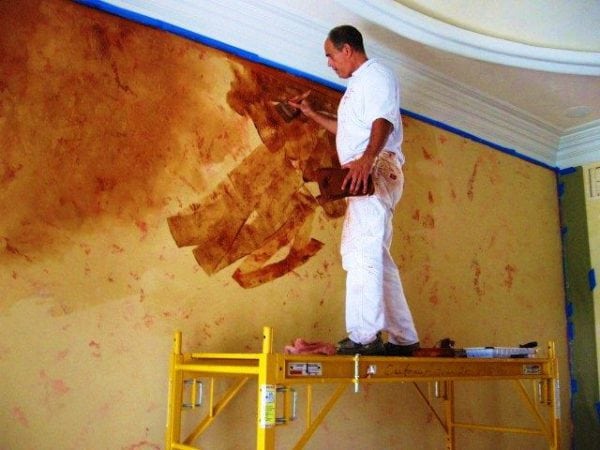Everyone wants to make their home unique. Therefore, wall decoration is always selected very carefully. There are many options: both expensive and quite economical. Painting walls in the style of “Venetian paint” is an opportunity for small money to create the effect of decorative plaster in your home or apartment.
- What is Venetian stucco?
- Latex coating technology
- Tools and materials
- Preparatory work
- Application technology
- Gold / Silver Decoration
- Oil Coating Technology

What is Venetian stucco?
This is one of the options for finishing walls. The end result is an exquisite surface that turns an ordinary home into a unique one. To apply the Venetian, you need to have specific knowledge and experience, so the work of masters is always expensive. Attempts to repeat their actions usually end in failure.
Therefore, an option appeared in the “cheap and cheerful” series - to imitate the effect of Venetian plaster with paint. To do this, as it turned out, is not so difficult. Labor costs are low, the price of consumables is available to almost everyone. The point is small - to understand what the surface should be.
The most popular and sought after are mixtures of Venetian plaster of noble natural shades. With their help, a surface is created that imitates the surface of natural stone:
- "Malachite" is an emerald color;
- "Granite" - gray color;
- "Marble" - white, pink.
Also, with the help of Venetian plaster, you can achieve the effect of golden brocade (a mixture of noble blue, green, burgundy colors with gold).
to contents ↑The material is demanding on surface quality. The same can be said about painting the walls with "Venetian paint." Therefore, the preparatory phase can not be avoided.
Latex coating technology
To achieve the result using a special application technique. It is also necessary to accurately select the ratio of dark and light colors. For the finishing touch, you can take silver or gold paint and with their help to make the surface of the walls embossed, creating unique patterns with the help of a crumpled plastic bag.
to contents ↑Tools and materials
To prepare a perfectly flat surface and obtain the desired result (painting an internal wall or ceiling), the following tools will be required:
- spatulas of various sizes;
- foam roller or plastic bag;
- trowel;
- sponge for drawing a picture;
- rags for cleaning paint stains;
- containers for water and mixtures;
- construction mixer;
- a large bucket of water;
- natural sea sponge (only not synthetic);
- color water-based paint of various shades;
- tray for paint;
- old cellophane to cover the floor from paint;
- masking tape;
- brush.
Preparatory work
Paint is demanding on surface quality.If the walls are not put in order, then all the bumps and flaws under the finish will be visible at a glance. Therefore, you can’t skip the preparatory stage:
- Clean the wall of the old finish - wallpaper, paint.
- Tap the surface - see if the stucco adheres well.
- If voids are found under the plaster, remove it. If the areas are large, then the wall will have to be “peeled” to a brick and plastered again.
- If the wall is more or less in normal condition, errors in the form of cracks, shells, protrusions need to be eliminated.
- Remove the tubercles with a hammer and chisel.
- Seal all pits and cracks with putty.
- Check the surface level. Differences of no more than 1 cm per meter are allowed. Otherwise, you will have to finish plastering.
- If everything is in order with the evenness of the wall, clean the surface with a fine sandpaper, then dedust it. The surface should be smooth to the touch.
- Prime the wall with a deep penetration compound.
- After drying, start work on staining.
Application technology
The order of work is simple, but it must not be violated. Prepare all the tools and materials so that they are at hand, be patient and proceed:
- Pour latex paint into two large plastic trays, filling them to the brim.
- Add a light color to one tray and a dark color to another.
- It is desirable that the dye is not mixed with the entire latex mass. On one side of the tray, the paint should be noticeably darker than on the other. To achieve the desired shade, add a little more dye.
- Put a little light weight on the plastic spatula.
- Gently spread the composition on the wall. Avoid sagging.
- Then put on the spatula a dark shade. The most important thing is to cover the wall with dark and light areas. This will simulate the appearance of Venetian plaster.
- Using a soft sponge in a chaotic manner, blend the colors obtained on the wall.
Be sure to use a plastic spatula to apply paint. Metal can damage the surface of the wall.
to contents ↑Gold / Silver Decoration
After the walls have dried, you can start applying the patterns. Pour some silver or gold paint into the tray (the choice depends on the basic tone of the surface). Crumple a plastic bag, dip it into the composition. Now proceed to decorate the surface. Randomly, but carefully apply gold blots on the wall. To organize the work, make a preliminary markup. As soon as the paint on the bag is dry, take a soft brush and lightly blend the spots. At the same time, their intermittent structure should be preserved.
Instead of a bag, you can use a porous sponge. The drawing and its structure will be different.
to contents ↑Oil Coating Technology
Walls for finishing must be prepared in the same way as when working with latex paints. And here are the differences:
- Cover the prepared wall transparent paint slightly pinkish tint.
- After the first coat has dried, apply the second.
- Prepare glaze (translucent) paint.
- Divide the wall (mentally) into strips of short length (10 centimeters).
- Apply a medium strip of paint onto the wall with a medium sized flute.
- Rub the paint against the wall with a wool rag. The more chaotic the movements, the better.
- Walk the wall with a dry, soft-bristle brush. This will help to blend the paint well.
- Wait for the surface to dry completely.
For cooking glaze paint you will need linseed oil, turpentine + desiccant (in a turpentine you need to add a couple of drops of desiccant), oil paint (tube). The ratio of linseed oil and diluted terpentine is 1: 2. Stir the ingredients until a homogeneous composition is obtained.Add half a tube of oil paint and rub until a uniform color is obtained.
Choose a shade so that the imitation of the Venetian is as close as possible - light ocher, natural siena, umber, brown mineral pigment (natural clay). The last two shades will help to create a mixture that perfectly imitates natural marble down to veins.
Using latex or glaze paints, without spending much effort, you can imitate Venetian plaster on the walls and ceiling of your home. It is important to choose the right ratio of colors and their shades. The paint does not have the effect of depth, this quality is peculiar only to the Venetian. Therefore, it depends on the chosen color whether the room visually increases or vice versa decreases.
For the walls of a small dark room, choose light shades, they can be combined with silver. In a large sunny room, you can use saturated green, blue, apricot, burgundy colors in combination with a warm sand or pale yellow base. To give a luxury effect, apply a golden pattern to the walls. For ceilings, the best solution would be to simulate sunset (gradient fill) or a blue sky with white clouds.







